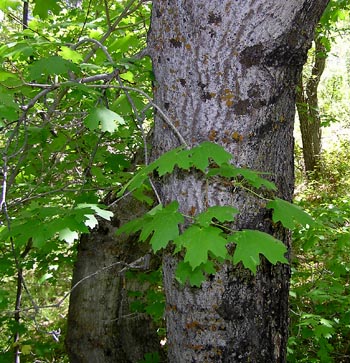Bigtooth Maple

Common Name(s):
Bigtooth Maple
Canyon Maple
Scientific Name:
Acer grandidentatum Nutt.
Scientific Name Synonyms:
None known
Symbol:
ACGR3
Description:
Life Span: Perennial
Origin: Native
Season: Deciduous
Growth Characteristics: A rather large, broadleaved shrub or small tree with a spreading, rounded crown. Its height will average about 35 feet, and the diameter averages 9 inches at maturity. Reproduces by wind-carried seeds contained in winged samaras.
Flowers/Inflorescence: Flowers are small, yellowish, and found in clusters appearing in early spring. Bigtooth maple usually only flowers every 2-3 years.
Fruits/Seeds: Fruits are typical double samaras, characteristic of maples. Two seeds are attached together at one end with extended wings projecting from opposite ends.
Leaves: The leaves arise from the twigs in opposing pairs. The general shape of the leaf is nearly round, about 4 inches in diameter with several blunt teeth around the edges. The leaf is characterized by 3, sometimes 5, lobes that fan out from the point of attachment to the leaf stalk.
Stems: Young twigs are slender, bright red to greenish-brown, and smooth. Older twigs are gray. Buds are reddish-colored and grow in clusters. Bark is thin with shallow furrows and grayish flat-topped ridges. The wood is hard, heavy, and light brown.
Ecological Adaptions:
Bigtooth maple is abundant in canyon bottoms, draws, and moist mountain sites, but can also be found in dryer areas. It is generally found between 4,500 and 7,500 feet elevation in north and central Utah. It is shade tolerant.
Soils: Bigtooth maple can be found on many soil types. It is intolerant of prolonged flooding and saline or alkaline soils. It is most often found on silty loams with a medium to rocky soil texture.
Associated Species: Chokecherry, boxelder, birchleaf mountain mahogany, gambel oak, peavine, Kentucky bluegrass, wheatgrasses.
Uses and Management:
Bigtooth maple is a good ground cover tree, providing shade in canyon bottoms for livestock and recreation areas. It is a fair source of food for browsing wildlife and domestic livestock. The seeds, buds, and flowers provide food for numerous species of birds and small mammals. Understory plants are generally lacking under stands of this tree.
Because this tree is closely related to the sugar maple of the Northeastern United States, it can and has been used as a source of sugar and syrup. The deciduous leaves of bigtooth maple account for most of the beautiful yellow, orange, and red coloration of our canyons in the early fall, and are used in "Autumn leaf" displays.

